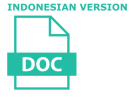Analisis Kesulitan Penggunaan Partikel Wa, No, Ni, De pada Siswa MAN 1 Kebumen
Swari Araminta Safama(1), Lispridona Diner(2*)
(1) Universitas Negeri Semarang
(2) Universitas Negeri Semarang
(*) Corresponding Author
Abstract
Errors in using Japanese particles are often made by Japanese language learners in Indonesia. The purpose of this study is to identify 1) the types of difficulties in using particles in Japanese sentences, 2) the underlying causes faced by students in the language and culture class at MAN 1 Kebumen, and 3) their strategies for resolving these issues. Descriptive quantitative research methodologies were used in this study. Tests and questionnaires were employed as research tools, with questionnaires distributed to 61 students. The findings indicated that the majority of respondents had trouble using the wa, ni, and de particles. Specifically, 75% of students struggled to place the particles correctly in a sentence, and up to 61% of students had difficulties understanding how to use them. These problems were caused by both internal and external factors, including a lack of willingness to learn about particles, inadequate explanations of particle functions in the textbook, insufficient self-learning of particle meaning and usage after class, and a teaching style perceived as less diversified by the students. To overcome these challenges, students employed various strategies such as taking notes about particles, searching for particle functions on the internet, consulting others who were more knowledgeable about the subject, asking friends, and seeking direct assistance from the teacher.
Keywords
Full Text:
PDFReferences
Ali, M. (1993). Penelitian Kependidikan Prosedur dan Strategi. Angkasa.
Amalia, A. (2013). Analisis Kesalahan Partikel Mahasiswa Program Studi Sastra Jepang Universitas Nasional PASIM. Kagami: Jurnal Pendidikan dan Bahasa Jepang, 4(1), 30-45. https://journal.unj.ac.id/unj/index.php/kagami/article/view/19964
Aprilianti, R., & Arianto, A. (2020). Interferensi Bahasa Indonesia dalam Penggunaan Partikel Bahasa Jepang Pada Karangan Mahasiswa STBA JIA. Ennichi, 1(1). http://ennichi.stba-jia.ac.id/index.php/ennichi/article/view/17
Arikunto, S. (2006). Prosedur Penelitian Suatu Pendekatan Praktik. Rineka Cipta.
Hernawati, Heni. (2020). Analisis Akustik Bunyi Sibilant Bahasa Jepang pada Pembelajar Bahasa Jepang di Indonesia yang Berbahasa Ibu Bahasa Jawa. Chi’e: Jurnal Pendidikan Bahasa Jepang, 8(2). https://doi.org/10.15294/chie.v8i2.40903
Iwabuchi, T. (1989). Nihon Bunpo Yoogo Jiten. Jidoo Gengo Kenkyuukai.
Japan Foundation. (2017). Survey Report on Japanese Language Education Abroad 2015. Japan Foundation. Diakses pada 20 Juli 2020, dari https://www.jpf.go.jp/e/project/japanese/survey/result/
Masroini, Marlina, L., & Zalman, H. (2019). Analisis Kesalahan Joshi Dalam Teks Sakubun Mahasiswa Tahun Masuk 2016 Program Studi Pendidikan Bahasa Jepang Universitas Negeri Padang. Omiyage: Jurnal Bahasa dan Pembelajaran Bahasa Jepang, 2(2), 27-31. https://doi.org/10.24036/omg.v2i2.138
Masuoka, T., Takubo, Y. (1992). Kiso Nihongo Bunpou. Kuroshio.
Matsumura, A. (1998). Daijirin. Sanseidou Co, Ltd.
Okimori, T. (2010). Nihongo Raiburarii – Nihongo Gaisetsu. Asakura Shoten.
Renariah. (2005). Gramatika Bahasa Jepang. Jurnal Sastra Jepang Fakultas Sastra Universitas Kristen Maranatha vol. 4(2).
Situmorang, H. (2007). Pengantar Linguistik Bahasa Jepang. USU Press.
Sudjianto, Dahidi, A. (2004). Pengantar Linguistik Bahasa Jepang. Kesaint Blanc.
Sudjianto, Dahidi, A. (2007). Pengantar Linguistik Bahasa Jepang. Kesaint Blanc.
Sugiyono. (2017). Metode Penelitian Pendidikan Pendekatan Kuantitatif, Kualitatif dan R&D. Alfabeta.
Sugiyono. (2014). Statistika untuk Penelitian. Alfabeta.
Sutedi, D. (2003). Dasar-dasar Linguistik Bahasa Jepang. Humaniora.
Sutedi, D. (2009). Penelitian Pendidikan Bahasa Jepang. UPI Press.
Sutedi, D. (2011). Penelitian Pendidikan Bahasa Jepang. UPI Press.
Article Metrics
Refbacks
- There are currently no refbacks.
Copyright (c) 2022 The Author(s)

This work is licensed under a Creative Commons Attribution-ShareAlike 4.0 International License.








